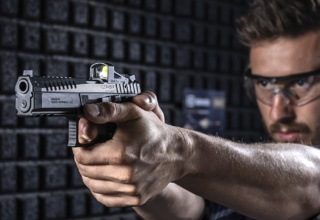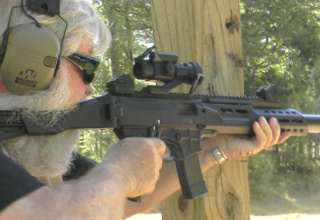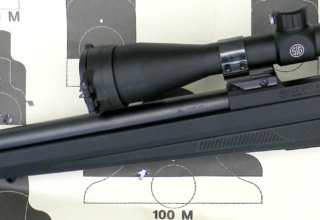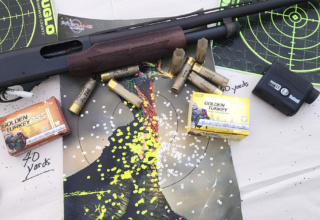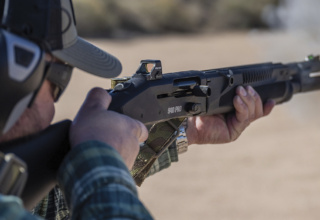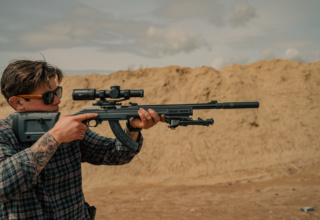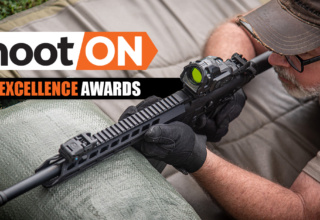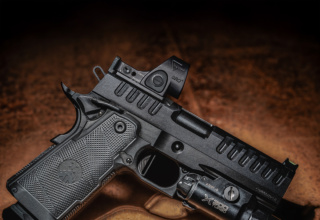When CZ-USA’s champion shooter Dave Miller aimed to set a new Guinness Book record, he corralled four of the country’s best youth shooters to get it done.
by Larry Case
Trying to describe David Miller shooting a shotgun is like attempting to tell your friends about the time you saw Bigfoot or a flying saucer. Unless you were there and saw it for yourself, well, it’s just hard to do. Miller hails from Grain Valley, Missouri, and is the shotgun Product Manager and Pro Shooter for CZ-USA. If ever there was a match made in heaven, this is it. After knowing Dave Miller for several years, I am convinced that something to do with a shotgun is on his mind about twenty-six hours a day.
Miller is a Master Class Sporting Clay shooter and he shoots 5 Stand, Skeet, and Trap as well. He is also a rabid pheasant hunter and, believe me, you don’t want to be the rooster that gets up in front of Mr. Miller. I have said it before—I shoot shotguns, you shoot shotguns, but nobody shoots shotguns like Dave Miller.
In 2015, I stood on a shotgun range in Kansas and watched Miller set the Guinness Book of World Records for the most clays broken with a shotgun in one hour: 3,653. He shot this event from the hip with a battery of thirty CZ-USA shotguns fitted with extended magazine tubes. Each gun held sixteen rounds. It was an amazing performance, and I figured the shotgun guru would be doing another shooting feat in the future.
Almost a year ago, Miller started planning for his latest attempt at a new Guinness Book of World Records mark—this time it was the greatest number of clays broken with shotguns by a five-person team in twelve hours. The previous record set by five gents in Dartford, England, was 4,602. I don’t think Dave Miller had much doubt that, with careful planning and preparation, he could beat this record with a good squad backing him up.

As to how Dave Miller chose the other four shooters for this event shows where his heart is for ensuring the future of the shotgun shooting sports world. A shotgunner of Miller’s reputation could have picked four well-known shooters and would probably have no trouble breaking the record, but he didn’t do that. Instead, he looked to the ranks of young shooters and held two qualifying shoots, one at the SCTP (Scholastic Clay Target Association) Nationals at the Cardinal Center in Marengo, Ohio, July 13-20, and at the A.I.M. & Grand Championship held at the World Shooting Complex in Sparta, Illinois, July 29-Aug 4, 2019. A.I.M. (Academics, Integrity, and Marksmanship) is a division of the Amateur Trapshooting Association for young shooters.
Here is the kicker for what Miller chose as the test to make it to the World Record attempt. Besides the best score for a round of fifty targets, applicants had to submit an essay explaining what the shooting sports means to them and why they should be a part of the attempt at breaking the record. Miller was not going to just get four good shotgun shooters; he was going to get two boys and two girls that could write and express themselves.
When the smoke cleared, four amazing young people had been chosen: Levi Henrichs from Sibley, Iowa, Jessica Strasser, Waterford, Wisconsin, Weston Zolck, Herman, Nebraska, and Makayla Scott from White Sulphur Springs, West Virginia. Now the stage was set for the World Record attempt at the Powder Creek Shooting Park in Lenexa, Kansas. The date was October 12—10/12, like the CZ-USA shotgun model 1012 semi-automatic that the shooters would use to attempt the record.

All the young people selected for the event were simply outstanding, and all had interesting stories as to how they got started in the shotgun sports, maybe none more so than Makayla Scott from West Virginia. After a less than advantageous start in life, Makayla was adopted into the family of Telford Scott in White Sulphur Springs. Early on, she tried to develop an interest in many of the standard sports and nothing seemed to fit. Makayla didn’t feel she was good at anything and had little self-confidence. Her brother was competing in shotgun events with 4-H Shooting Sports, and he suggested Makayla try the shotgun.
The rest, as they say, is history. Makayla took up the shotgun and never looked back. She has competed in and won many state titles, and she shot well enough to be selected for the World Record event. Makayla is now looking at a run for the Olympics, the chance of college scholarships for shotgun shooting, and the possibility of jobs in the shooting industry. The sky is now the limit.

Shooting a shotgun changed Makayla’s life.
October 12 dawned clear and cold in Lenexa, Kansas, and an almost festive, carnival atmosphere prevailed as the shooters prepared to take their place on the line to begin shooting for the record. At exactly 10:12 a.m., Weston Zolck called for the first targets and two Chandelle-type targets sprang into the air thirty yards away. At the report of the shotgun two more targets were launched. As soon as Weston fired his last round, the next shooter, Jessica Strasser, called for her targets. With some short breaks, this would go on for the next twelve hours.
Twelve hours is a long time when you are watching something; it’s much longer if you are shooting a shotgun for that length of time. Several times, I would go and stand behind the shooters and just watch them work. Levi Henrichs was so fast on the trigger I couldn’t see how he got on target for the second clay so fast. Weston Zolck was about the same. BOOM, BOOM! Very fast…
Watching the girls, Jessica and Makayla, I marveled at how they handled the recoil. The CZ 1012 is a nice semi-auto shotgun. I shot it and liked it. I didn’t think it had a lot of recoil for an inertia-powered shotgun, but there is some recoil involved and it showed a little as the ladies shot their targets. Whatever Jessica and Makayla were experiencing in felt recoil, it didn’t seem to influence them or their shooting. They were hanging right in there as the evening progressed, and their hit percentage rose as time went on.
Events like this take a massive amount of planning and logistical effort. Sponsors for the event—CZ-USA, Aguila ammunition (20,425 rounds of shotshells fired and I didn’t see the first problem with the ammo), MEC Outdoors clay throwers, White Flyer targets (17,250 clays were thrown), Wild Hare Shooting Gear, Scholastic Clay Target Association, Amateur Trapshooting Association, Risher Fitness Equipment, and Powder Creek Shooting Park—are all to be congratulated for supporting an event that will have long lasting effects on the future of shooting sports.
When the final bell rang at 10:12 pm there was joyous celebration among the shooters, friends, family, and onlookers that had gathered to watch this historic event. Dave Miller and his young guns had broken 14,167 clay targets in twelve hours! I saw tears of joy and many hugs from the family that gathered around the proud shooters. Guinness Book of World Record officials, who had been present the entire time to count and oversee the event, announced that the team had, in fact, shattered the old record.
Shooting a shotgun is fun. It shouldn’t have taken a monumental event like this to remind me of that, but it did. You don’t have to shoot like Dave Miller or fire thousands of rounds every week to get out and enjoy a round of trap or sporting clays with your friends and family. Same for hunting. Small game and bird hunting with a shotgun is available on most public hunting areas all over the country. These activities don’t require a lot of time, planning, or expenses. Just go do it.
That’s what Dave Miller and his band of young guns did; they just went out and did it—14,167 clays in twelve hours. I think that number is going to stand for along time.
Dave Miller’s Shotgun Shooting Tips
Along with all his other activities, Dave Miller is a highly sought-after shotgun instructor. Here are five common mistakes us shotgunners make and advice from Dave on how to deal with them. Remember, some tips are specific for bird hunting, some for clay shooting, and some will help with both.
Looking at the gun first. “You can’t shoot what you can’t see,” Dave said. “Train yourself to look at the target, and then move the gun.” Miller noted that it is not necessary to “see” the gun—that is, the rib and the end of the barrel—if your eyes are on the target and you mount the gun properly. “Remember, its eyes first, then the gun,” he said.
In hunting situations, Miller noted it is important to concentrate on a flushing or incoming bird. Is it a hen or a rooster pheasant? What species of waterfowl might it be? Also, clearly seeing the target and what is beyond it addresses obvious safety concerns.
Not moving to the target. Ever had a grouse or pheasant erupt from cover as you face an angle away from the bird? Of course, you have. We take the shot from this awkward, twisted position and most always, we miss. Miller stressed that moving to the target—“step to the shot”—is very important. “You have to take the time to move your feet and step in front of the target,” he said. “In this way, you are in the proper body position to move the gun in front of the bird. Think about starting with the gun ahead of the bird, even at the low ready position.”
There is plenty of time to do this. When that grouse or pheasant or quail explodes out of cover, we tend to think we must shoot immediately or lose out. How fast is that pheasant flying, maybe forty-five miles an hour? Check the velocity on the shotshell box you are using. Thirteen hundred feet per second is almost 900 miles an hour. You have time to step into the shot and get into the right position.
Not inserting the muzzle ahead of the target. “There is nothing good on the backside of the target,” Miller said. “Never get behind, always mount the gun ahead of the target.” “In wing shooting, most birds are taken with a “cut off” move, which is where the muzzle is inserted in front of the bird from a line different than that of the target to cut it off,” he said.
In clay target situations, the cut off move is usually applied when the shooter is moving from the first target to the second in doubles. The shooter kills the first clay and then moves the muzzle directly in front of the second to cut it off.
Fearing the rabbit. Many sporting clay shooters get spooked by the “rabbit” station. The way the target is presented, bouncing along the ground at a speed likened to an aspirin shot out of a .257 Roberts, can give any shooter the heebee geebees. “Remember, the rabbit is a type of target, not just the presentation,” Miller said. “This clay is thicker and harder to break than other clays.”
“The rabbit is heavy and loses its spin faster than other targets,” Dave said. “Targets break easier when they are spinning; in clay shooting centrifugal force is your friend.” For this reason, Miller reasoned the shooter may want to plan to break the target while it is under power to take advantage of the spin.
Not establishing a routine. “A shooting scenario can’t end the same way every time, that is, successfully, unless you start the start the same way every time,” Miller said. The CZ-USA Pro Shooter stresses establishing a routine and doing it the same way every time.
“Think about these steps when you enter the box to shoot,” Dave said. First, where is the target coming from? Second, where can I see it the best? This is where I want to kill it. Third, adjust your body and foot placement for that position. Fourth, start the gun between where you will begin to see the bird and the point where you want to break it. “So, I am looking at point A, and I am going to break the clay when it gets to point B. I will start the gun about in the middle of these two places, about a 50% hold point.”
For wing shooting applications Dave Miller suggested keeping with a routine as much as possible, even carrying the shotgun the same way, having both hands in the correct place with the barrel angled up into a safe position. When stepping into the shot—the “stutter step” that you do to position yourself and place the gun in front of the bird—do it the same way every time. Following these simple steps will put more Xs on your score sheet and more birds in the bag.
Honestly, I don’t except to become a shooter on the level of Dave Miller any time soon, but I do know if I follow these tips to correct mistakes, I will hit more birds, clays, and feathers. I might even hit that dang rabbit a little more often.





